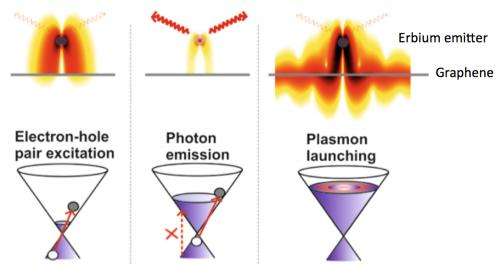Graphene enables all-electrical control of energy flow from light emitters

At the heart of lasers, displays and other light-emitting devices lies the emission of photons. Electrically controlled modulation of this emission is of great importance in applications such as optical communication, sensors and displays. Moreover, electrical control of the light emission pathways opens up the possibility of novel types of nano-photonics devices, based on active plasmonics.
Scientists from ICFO, MIT, CNRS, CNISM and Graphenea have now demonstrated active, in-situ electrical control of the energy flow from erbium ions into photons and plasmons. The experiment was implemented by placing the erbium emitters a few tens of nanometers away from the graphene sheet, whose carrier density (Fermi energy) is electrically controlled. Partially funded by the EC Graphene Flagship, this study entitled "Electrical control of optical emitter relaxation pathways enabled by graphene", has been published in Nature Physics.
Erbium ions are essentially used for optical amplifiers and emit light at a wavelength of 1.5 micrometers, the so called third telecom window. This is an important window for optical telecommunications because there is very little energy loss in this range, and thus highly efficient information transmission.
The study has shown that the energy flow from erbium into photons or plasmons can be controlled simply by applying a small electrical voltage. The plasmons in graphene are rather unique, as they are very strongly confined, with a plasmon wavelength that is two orders of magnitude smaller than the wavelength of the emitted photons. As the Fermi energy of the graphene sheet was gradually increased, the erbium emitters went from exciting electrons in the graphene sheet, to emitting photons or plasmons. The experiments revealed the long-sought-after graphene plasmons at near-infrared frequencies, relevant for these telecommunications applications. In addition, the strong concentration of optical energy offers new possibilities for data storage and manipulation through active plasmonic networks.
Frank Koppens commented: "This work shows that electrical control of light at the nanometer scale is possible and efficient, thanks to the optoelectronics properties of graphene."
More information: Electrical control of optical emitter relaxation pathways enabled by graphene, Nature Physics. K. J. Tielrooij, L. Orona, A. Ferrier, M. Badioli, G. Navickaite, S. Coop, S. Nanot, B. Kalinic, T. Cesca, L. Gaudreau, Q. Ma, A. Centeno, A. Pesquera, A. Zurutuza, H. de Riedmatten, P. Goldner, F. J. García de Abajo, P. Jarillo-Herrero and F. H. L. Koppens. DOI: 10.1038/NPHYS3204
Journal information: Nature Physics
Provided by The Institute of Photonic Sciences




















